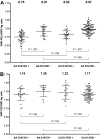Common VWF exon 28 polymorphisms in African Americans affecting the VWF activity assay by ristocetin cofactor
- PMID: 20231421
- PMCID: PMC2910611
- DOI: 10.1182/blood-2009-10-249102
Common VWF exon 28 polymorphisms in African Americans affecting the VWF activity assay by ristocetin cofactor
Abstract
The diagnosis of von Willebrand disease relies on abnormalities in specific tests of von Willebrand factor (VWF), including VWF antigen (VWF:Ag) and VWF ristocetin cofactor activity (VWF:RCo). When examining healthy controls enrolled in the T. S. Zimmerman Program for the Molecular and Clinical Biology of von Willebrand disease, we, like others, found a lower mean VWF:RCo compared with VWF:Ag in African American controls and therefore sought a genetic cause for these differences. For the African American controls, the presence of 3 exon 28 single nucleotide polymorphisms (SNPs), I1380V, N1435S, and D1472H, was associated with a significantly lower VWF:RCo/VWF:Ag ratio, whereas the presence of D1472H alone was associated with a decreased ratio in both African American and Caucasian controls. Multivariate analysis comparing race, SNP status, and VWF:RCo/VWF:Ag ratio confirmed that only the presence of D1472H was significant. No difference was seen in VWF binding to collagen, regardless of SNP status. Similarly, no difference in activity was seen using a GPIb complex-binding assay that is independent of ristocetin. Because the VWF:RCo assay depends on ristocetin binding to VWF, mutations (and polymorphisms) in VWF may affect the measurement of "VWF activity" by this assay and may not reflect a functional defect or true hemorrhagic risk.
Figures







Comment in
-
Redeeming ristocetin.Blood. 2010 Jul 15;116(2):155-6. doi: 10.1182/blood-2010-04-276394. Blood. 2010. PMID: 20634385 No abstract available.
References
-
- Rodeghiero F, Castaman G, Dini E. Epidemiological investigation of the prevalence of von Willebrand's disease. Blood. 1987;69(2):454–459. - PubMed
-
- Sadler JE, Mannucci PM, Berntorp E, et al. Impact, diagnosis and treatment of von Willebrand disease. Thromb Haemost. 2000;84(2):160–174. - PubMed
-
- Sadler JE, Budde U, Eikenboom JC, et al. Update on the pathophysiology and classification of von Willebrand disease: a report of the Subcommittee on von Willebrand Factor. J Thromb Haemost. 2006;4(10):2103–2114. - PubMed
-
- Tosetto A, Rodeghiero F, Castaman G, et al. Impact of plasma von Willebrand factor levels in the diagnosis of type 1 von Willebrand disease: results from a multicenter European study (MCMDM-1VWD). J Thromb Haemost. 2007;5(4):715–721. - PubMed
-
- Kitchen S, Jennings I, Woods TA, Kitchen DP, Walker ID, Preston FE. Laboratory tests for measurement of von Willebrand factor show poor agreement among different centers: results from the United Kingdom National External Quality Assessment Scheme for Blood Coagulation. Semin Thromb Hemost. 2006;32(5):492–498. - PubMed
Publication types
MeSH terms
Substances
Grants and funding
LinkOut - more resources
Full Text Sources
Miscellaneous

